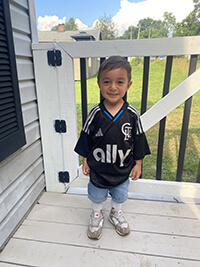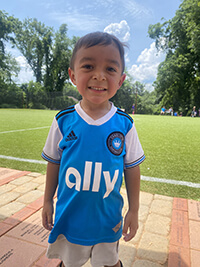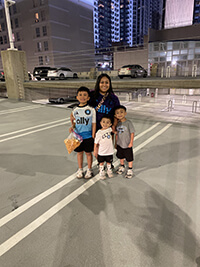
On any given afternoon, you can find 3-year-old Santiago Arellano racing across the yard after a soccer ball, his laughter trailing behind his two older brothers. A devoted Charlotte FC fan, he never misses a match, whether he’s waving a scarf in the stands or cheering them on from the couch with his family.
Outgoing and curious, Santiago rarely meets a stranger. He forms fast connections, especially with his beloved aunt, and carries a spark that seems to brighten every room.
“Santi’s spirit and determination are contagious,” says Santiago’s mom, Claudia. “Watching him navigate his world with such strength makes us more grateful for every single day.”
That same strength has carried Santiago and his family through a journey that began long before he took his first steps.
A diagnosis before birth
Claudia still remembers the moment her world shifted. She was pregnant and had gone in for her 20-week anatomy scan, expecting a routine checkup. Instead, she found herself alone in a doctor’s office, trying to process the unexpected news: her baby had spina bifida.
“I felt so empty getting the news,” Claudia says. “I was anxious, sad, confused, and I didn’t really understand what it meant. I went home and did my own research. It was extremely overwhelming.”
This finding meant the remainder of her pregnancy required careful monitoring with Dr. Rebecca Alison Mokhiber Pierce-Williams at Atrium Health Women’s Care Maternal Fetal Medicine. Weekly ultrasounds would ultimately help Claudia prepare for the challenges ahead and help her and her husband find steadiness while also raising their two young sons, then just five and two.
A challenging start
Santiago was born at Atrium Health Carolinas Medical Center and spent three days in the neonatal intensive care unit (NICU) at Atrium Health Levine Children’s Hospital. He arrived with a cyst on his spine, but his first MRI showed no signs of hydrocephalus — a condition where excess fluid builds up in the brain and can cause dangerous pressure if untreated. However, he still needed close monitoring.
At six months, a follow-up MRI revealed a tethered spinal cord. Dr. Scott Wait, pediatric neurosurgeon and the medical director of pediatric neurosurgery at Levine Children's Hospital, performed surgery to remove the cyst, a benign fatty tumor (lipoma), and to detether the spinal cord. When the cord reattached, a second surgery was needed when Santiago was 23 months old.
The recoveries were delicate and emotionally intense. Claudia remembers how vulnerable those moments felt.
“He had to be completely flat after surgery. I was so afraid to even pick him up,” Claudia says. “But the nurses and doctors were so supportive. They walked me through everything and made sure I never felt alone.”
And though he had already endured so much, this was only a portion of his medical journey.
Fighting infections, finding answers
 By Santiago’s first birthday, he had also faced five febrile urinary tract infections (UTI) — a common complication of spina bifida. Each episode raised new concerns about his kidney health, and further testing revealed that he had neurogenic bladder, meaning his bladder wasn’t emptying properly because electrical signals between the nervous system and bladder function were disrupted.
By Santiago’s first birthday, he had also faced five febrile urinary tract infections (UTI) — a common complication of spina bifida. Each episode raised new concerns about his kidney health, and further testing revealed that he had neurogenic bladder, meaning his bladder wasn’t emptying properly because electrical signals between the nervous system and bladder function were disrupted.
His pediatrician knew exactly what to do and sent the family back to Levine Children’s Hospital. But this time with a referral to see the urology team, named a ‘Best Children's Hospital’ for pediatric urology by U.S. News & World Report. They began working closely with pediatric urologist, Dr. Alison Keenan, who recommended catheterizing Santiago twice a day to help his bladder empty more fully.
At first, Claudia was hesitant. The idea of manually placing a catheter felt overwhelming. But as she monitored Santiago’s nighttime output — sometimes 10 to 12 ounces of urine, along with visible bloating — it became clear that twice a day wasn’t enough.
With Dr. Keenan’s guidance, they increased the frequency, and the change made a dramatic difference.
“Dr. Wait and Dr. Keenan have been amazing. They have helped transform Santi’s health,” Claudia says. “And all the nurses have been wonderful and always so caring. They have taken care of us like family.”
Since adjusting his care plan, Santiago hasn’t had another UTI.
“Having a child with a disability changes the way I see things,” Claudia adds. “But seeing the teams work together and knowing all of his doctors are in communication has given us so much peace.”
Looking ahead with hope
 Today, Santiago is a joyful three-year-old who loves his family, his friends and his favorite soccer team. He wears ankle-foot orthotics to support his mobility as he runs and plays with his brothers. He also attends weekly physical therapy sessions, which his family views as another opportunity for him to grow stronger.
Today, Santiago is a joyful three-year-old who loves his family, his friends and his favorite soccer team. He wears ankle-foot orthotics to support his mobility as he runs and plays with his brothers. He also attends weekly physical therapy sessions, which his family views as another opportunity for him to grow stronger.
“He’s able to walk, and that’s such a blessing,” Claudia says. “We’re so proud of how far he’s come.”
Santiago continues to follow up with neurology and urology, and he’s scheduled for a full MRI in 2026 unless symptoms arise sooner.
“The way I see things now after all we’ve been through, I try to treat people the way they treated me: with compassion and patience,” Claudia says. “Thank you will never be enough for everything the doctors and nurses have done for us.”
To other parents and caregivers facing a similar medical experience, Claudia offers this message:
“Don’t give up. Have faith. Sometimes, we’re tested not to show our weaknesses, but to discover our strengths.”



